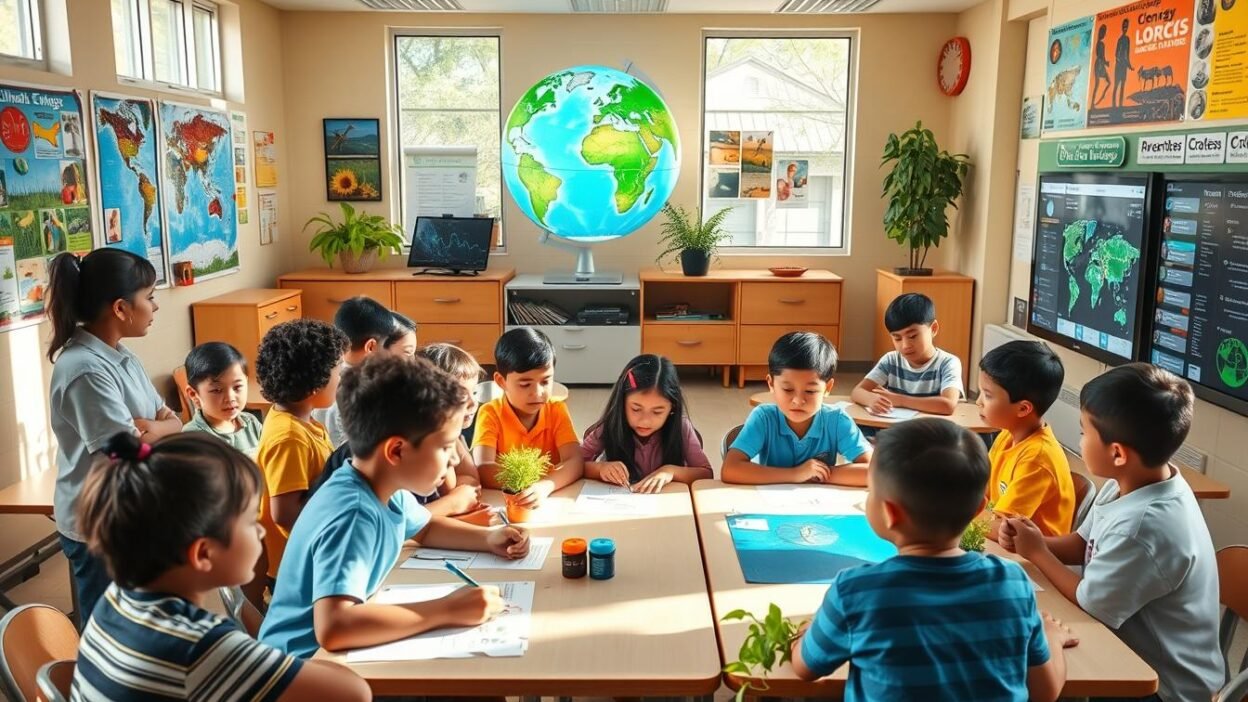Our next generation needs better preparation to face climate change realities. The world faces urgent environmental challenges. Climate change education is key to building a sustainable future.
Educators empower students with vital knowledge and skills. They help shape a resilient world by addressing the climate crisis. This role has never been more important.
Climate change education goes beyond teaching scientific facts. It cultivates environmental stewardship and critical thinking. It instills a sense of responsibility towards our planet.
Educators can foster a holistic understanding of climate issues. They do this by integrating the topic across various disciplines. This approach inspires students to become change agents.
Aspiring teachers preparing for UGC NET Paper 1 should focus on climate change education. It’s crucial for teaching methodology and research aptitude. Understanding its significance is paramount.
Educators need the right knowledge and teaching methods. This equips them to guide students effectively. They can help students navigate climate change complexities and develop innovative solutions.
Key Takeaways
- Climate change education is crucial for building a sustainable future
- Educators play a vital role in empowering students to address environmental challenges
- Integrating climate change topics across disciplines fosters a holistic understanding
- UGC NET Paper 1 emphasizes the importance of climate change education in teaching methodology and research aptitude
- Equipping educators with knowledge and pedagogy is essential for guiding students in navigating climate change complexities
The Urgency of Addressing Climate Change in Education
Our world faces serious environmental challenges. We must address climate change through education. Climate change affects everything from the economy to public health.
We need to prepare future generations. They must learn to tackle these challenges. We should teach them about sustainable development.
Climate change education is vital at all levels. It helps students understand the issue better. This knowledge empowers them to make informed decisions and take action.
An interdisciplinary approach to climate change education is key. It lets students explore the issue from many angles. This method helps develop a complete understanding of the problem.
We can include climate change in various subjects. These include science, social studies, and even art. This approach gives students a well-rounded view of the issue.
“Education is the most powerful weapon which you can use to change the world.” – Nelson Mandela
Climate change education should extend beyond classrooms. We must involve communities and stakeholders. This creates a sense of shared responsibility.
Working together is crucial. It’s how we’ll build a more sustainable future. Our efforts today will benefit generations to come.
Integrating Climate Change Education Across Disciplines
Climate change education requires an interdisciplinary approach. This helps students understand its complex challenges and far-reaching impacts. By learning across disciplines, students can develop skills to build a sustainable future.
Science and Technology
Science and technology are key to understanding climate change processes. Students can learn about the greenhouse effect and carbon cycle through climate science curricula. Hands-on activities like data analysis help develop critical thinking skills.
Modeling future scenarios can enhance problem-solving abilities. These practical exercises make complex concepts more accessible to students.
Social Sciences and Humanities
Social sciences offer insights into the human aspects of climate change. Geography, economics, and political science explore factors contributing to climate change. These disciplines also examine its unequal impacts on different communities.
Case studies and discussions deepen understanding of society-environment interactions. Ethics helps students explore moral dimensions of climate change and environmental values.
| Discipline | Climate Change Education Focus |
|---|---|
| Geography | Spatial distribution of climate impacts, vulnerability, and adaptation |
| Economics | Economic costs of climate change, carbon pricing, green investments |
| Political Science | Climate policies, international negotiations, environmental justice |
| Ethics | Moral dimensions of climate change, intergenerational equity, environmental values |
Arts and Creative Expression
Arts offer powerful tools for emotional engagement with climate change. Visual arts, music, and literature explore personal experiences of living in a changing climate. Creating artistic works helps students develop empathy and communicate their concerns.
“Art has the power to transform, to illuminate, to educate, inspire and motivate.” – Harvey Fierstein
An interdisciplinary approach provides a holistic understanding of climate change. It integrates science, social sciences, humanities, and arts. This empowers students to become agents of change for a sustainable future.
Developing Critical Thinking Skills Through Climate Change Education
Climate change education helps students build critical thinking skills. It teaches them to solve problems and make smart choices. Students learn to analyze data and draw informed conclusions about environmental issues.
Project-based learning is a great way to boost critical thinking. Students can design eco-friendly plans for their communities. They might create campaigns to promote green practices. These projects help apply knowledge and spark creativity.
Climate change education also encourages looking at different viewpoints. Students examine ideas from policymakers, scientists, and activists. This helps them form well-reasoned arguments about complex issues. It prepares them to face climate change challenges.
Studying climate change across subjects promotes interdisciplinary thinking. Students connect ideas from science, social studies, and math. This helps them understand environmental issues better. They develop a systems-thinking mindset to tackle climate change.
| Critical Thinking Skill | Application in Climate Change Education |
|---|---|
| Problem-solving | Designing sustainable solutions for local communities |
| Decision-making | Evaluating evidence and making informed choices |
| Logical reasoning | Analyzing data and drawing evidence-based conclusions |
| Interdisciplinary thinking | Connecting concepts from various disciplines |
Climate change education equips students with vital tools for a sustainable future. It teaches them to analyze, evaluate, and make smart decisions. These skills empower students to tackle climate challenges head-on.
Fostering Environmental Stewardship and Responsibility
Climate change education is vital for students’ environmental stewardship. It helps them understand human impact on the environment. This knowledge inspires sustainable choices and actions to fight climate change.
Hands-on learning connects students to nature. It sparks a desire to protect our world. Schools can nurture responsible global citizens by teaching environmental care.
Integrating these practices into daily life makes a big difference. Students can reduce their carbon footprint and help create a healthier planet. Simple actions like saving energy and minimizing waste are key.
Encouraging Sustainable Lifestyle Choices
Climate change education aims to promote sustainable living. This includes reducing energy use, minimizing waste, and choosing eco-friendly products. These small changes can have a big impact on our planet’s health.
Educators can promote sustainable lifestyle choices by:
- Incorporating lessons on energy conservation and efficiency
- Encouraging the use of reusable products and reducing single-use plastics
- Promoting plant-based diets and sustainable food choices
- Highlighting the benefits of active transportation, such as walking or cycling
Promoting Community Engagement and Action
Climate change education extends beyond the classroom. Schools can empower students to become change agents in their communities. This involves joining cleanup projects, supporting sustainable policies, and raising awareness about climate change.
“Never doubt that a small group of thoughtful, committed citizens can change the world; indeed, it’s the only thing that ever has.” – Margaret Mead
Empowering students creates a ripple effect of positive change. It helps them develop leadership skills and build connections. Through community engagement, students contribute to a more sustainable and resilient society.
Preparing Educators for Climate Change Education
Climate change education is crucial for a sustainable future. Educators need proper training to teach this complex topic effectively. Comprehensive preparation and ongoing development are key.
These opportunities equip teachers with knowledge and skills. They help build confidence to engage students in meaningful learning experiences about climate change.
Various professional development options can support educators. These should be tailored to their specific needs and contexts. Here are some examples:
- Workshops and seminars focused on climate science, impacts, and solutions
- Training in innovative teaching methodologies and pedagogical approaches
- Peer learning and networking opportunities to share best practices and experiences
- Access to cutting-edge research and educational resources on climate change
Ongoing resources and support are vital for successful climate change education. These can include:
- Curating and disseminating high-quality educational materials and lesson plans
- Establishing online platforms and communities for resource sharing and collaboration
- Offering mentoring and coaching programs to support teachers in implementing climate change education
- Providing access to expert speakers, field trips, and experiential learning opportunities
Professional Development Opportunities
Comprehensive programs are essential for effective climate change education. Here are some examples:
| Professional Development Opportunity | Description |
|---|---|
| Climate Science Institute | Intensive summer program for teachers to deepen their understanding of climate science and pedagogy |
| Online Climate Education Course | Self-paced, interactive course covering key topics in climate change education |
| Climate Education Leadership Program | Year-long program to develop teacher leaders in climate change education |
Resources and Support for Teachers
Ongoing resources empower teachers to deliver effective climate change education. Consider these strategies:
“Equipping educators with the tools, resources, and support they need is vital to the success of climate change education initiatives. By investing in our teachers, we invest in the future of our planet.”
Prioritizing educator preparation and professional development is crucial. Access to resources and support helps build teacher capacity. This approach fosters meaningful learning experiences about climate change.
Students can develop knowledge, skills, and values for a sustainable future. Investing in teachers is an investment in our planet’s future.
Leveraging Technology for Effective Climate Change Education
Technology is a powerful tool for enhancing climate change education. Digital tools create engaging learning experiences. These experiences foster a deeper understanding of climate change complexities.
Remote learning has expanded climate change education’s reach. Students from diverse backgrounds can access high-quality content. Online platforms enable global collaboration and knowledge sharing.
Technology helps develop essential communication skills about climate change. Online discussions and digital storytelling improve students’ articulation. These tools allow students to engage in constructive dialogue and advocate for action.
Digital tools provide access to scientific data and research papers. Students can explore various aspects of climate change. This creates an immersive learning environment that encourages critical thinking.
“Technology is a powerful ally in the fight against climate change. By harnessing its potential in education, we can inspire a new generation of informed and empowered climate champions.”
Technology has transformative potential in climate change education. Digital tools equip students with knowledge and skills. This empowers them to become active agents of change for a sustainable future.
Addressing Misconceptions and Misinformation About Climate Change
Climate change education is vital for our future. It’s crucial to tackle misconceptions and misinformation about this pressing issue. Educators can help students understand scientific facts and the need for action.
Identifying Common Myths and Misconceptions
Many myths about climate change persist despite scientific evidence. These myths often mislead people about the reality of our changing climate.
- Climate change is a natural phenomenon and not caused by human activities
- The Earth is not warming, or the warming is not significant
- Climate change is not a serious threat to the environment or human society
- Individual actions have no impact on mitigating climate change
Educators must address these misconceptions directly. They should provide accurate information to students. This helps develop critical thinking skills to spot misinformation.
Strategies for Countering Misinformation
Educators can use several strategies to counter climate change misinformation:
- Fact-checking: Encourage students to verify information from reliable sources, such as scientific journals, government agencies, and reputable environmental organizations.
- Data interpretation: Help students understand how to interpret scientific data and graphs, enabling them to draw accurate conclusions about climate change trends and impacts.
- Critical thinking: Foster critical thinking skills by engaging students in discussions, debates, and problem-solving activities that challenge them to question their assumptions and consider multiple perspectives.
- Empowering action: Emphasize the importance of individual and collective action in addressing climate change, highlighting the power of informed decision-making and advocacy.
These strategies help students navigate complex climate change information. They can become informed, engaged citizens ready to tackle environmental challenges.
| Myth | Fact |
|---|---|
| Climate change is natural | Human activities are the primary driver of current climate change |
| The Earth is not warming | Global temperatures have risen significantly since the industrial revolution |
| Climate change is not a serious threat | Climate change poses severe risks to ecosystems, human health, and economies |
| Individual actions have no impact | Collective individual actions can make a significant difference in mitigating climate change |
Education is the most powerful weapon which you can use to change the world.
Climate change education can shape a sustainable future. By addressing misconceptions, we empower students with accurate information. This knowledge helps build a more resilient world.
UGC NET Paper 1: Incorporating Climate Change Education in Teaching Methodology and Research Aptitude
Climate change education is vital for today’s educators. The UGC NET Paper 1 offers a chance to include this topic in higher education. It equips future teachers with knowledge to tackle this global issue.
Integrating Climate Change Topics in Teaching Methodology
Educators can use various strategies to teach about climate change. They can use real-world examples to engage students and make the topic relatable. Interdisciplinary approaches can show how climate change connects to different subjects.
Student-led projects and discussions can boost critical thinking skills. These methods create an impactful learning experience about climate change’s complexities.
- Incorporate climate change case studies and real-world examples to engage students and make the topic more relatable
- Use interdisciplinary approaches to demonstrate the interconnectedness of climate change with various subjects
- Encourage student-led projects and discussions to foster critical thinking and problem-solving skills
Developing Research Aptitude in Climate Change Education
Research aptitude in climate change education is crucial. It helps us understand this complex issue better. Educators can nurture research skills among students in several ways.
| Strategy | Description |
|---|---|
| Collaborative research projects | Encourage students to work together on climate change research projects, fostering teamwork and knowledge sharing |
| Interdisciplinary approach | Promote research that spans across different disciplines, highlighting the multifaceted nature of climate change |
| Mentorship programs | Connect students with experienced researchers and experts in the field to guide and inspire their research endeavors |
Developing research aptitude in climate change education is not only about acquiring knowledge but also about nurturing a sense of curiosity, critical thinking, and problem-solving skills that will serve students well beyond their academic careers.
Climate change education in UGC NET Paper 1 prepares the next generation for a pressing challenge. Innovative teaching and research focus can deepen understanding of climate change. It can inspire students to become agents of change for a sustainable future.
Building Partnerships for Climate Change Education
Climate change education needs teamwork beyond the classroom. Partnerships with NGOs, environmental groups, and communities are vital. These collaborations enhance teaching and engage students in meaningful learning.
Working together gives educators access to valuable resources and expertise. It also supports them in creating impactful learning experiences. Such partnerships foster a sustainable future.
Collaborating with NGOs and Environmental Organizations
NGOs and environmental groups lead climate change research and action. Partnering with them gives educators current info and hands-on learning chances. Students can connect with experts and gain real-world insights.
These partnerships offer up-to-date materials and resources. They help create comprehensive climate change education programs. Educators can leverage expert knowledge to enhance their teaching.
Engaging with Local Communities and Stakeholders
Involving local communities builds ownership in addressing climate change. Educators can team up with leaders, businesses, and government for sustainable projects. This approach raises awareness and promotes eco-friendly practices.
Student involvement in these partnerships fosters agency. It empowers them to shape a sustainable future. Community engagement extends climate education beyond the classroom.
These collaborations create tangible environmental and social impact. They help students become active participants in positive change. Local partnerships make climate education more relevant and actionable.
FAQ
Why is climate change education crucial for building a sustainable future?
Climate change education empowers students to tackle environmental challenges. It equips the next generation with knowledge and skills to combat climate change. This education creates informed citizens who can take action for a sustainable future.
How can educators integrate climate change education across various disciplines?
An interdisciplinary approach provides a comprehensive understanding of climate change. Educators can weave climate topics into science, social sciences, humanities, and arts. Science classes explore the scientific basis, while social sciences discuss its societal impacts.
The arts can creatively express the urgency of addressing climate change. This varied approach ensures students grasp the issue from multiple angles.
What role does climate change education play in developing critical thinking skills?
Climate change education enhances critical thinking skills. Students analyze data, evaluate evidence, and consider multiple perspectives. This process improves their problem-solving and decision-making abilities.
It encourages logical thinking and questioning assumptions. These skills are vital for tackling climate change challenges.
How can educators foster environmental stewardship and responsibility among students?
Educators can promote environmental stewardship by encouraging sustainable lifestyle choices. They can teach about reducing carbon footprints and conserving resources. Organizing community projects helps students understand the impact of their actions.
Tree planting or waste reduction campaigns show the importance of collective efforts. These activities make climate action tangible for students.
What professional development opportunities are available for educators to effectively teach about climate change?
Educators can access various professional development opportunities to enhance their climate change teaching skills. Workshops, seminars, and online courses focus on climate science and teaching strategies.
Educational institutions provide resources like lesson plans and multimedia materials. Expert guidance is also available to help integrate climate education into teaching practices.
How can technology be leveraged to enhance climate change education?
Technology offers many ways to boost climate change education. Digital tools like simulations and data visualizations make learning more engaging. Online resources expand access to climate education.
Remote learning opportunities connect students globally. Technology facilitates collaboration among students, educators, and experts in this field.
What strategies can educators use to address misconceptions and misinformation about climate change?
Educators can tackle climate change misconceptions by identifying common myths. They should provide evidence-based information from reliable sources to counter these myths. Encouraging critical thinking and fact-checking helps students navigate complex climate information.
Teaching media literacy skills is crucial in this process. It empowers students to discern credible information about climate change.
How can educators incorporate climate change education into UGC NET Paper 1 preparation?
Climate change education fits well into UGC NET Paper 1’s focus on teaching and research. Educators can design lesson plans exploring multidisciplinary aspects of climate change. They can develop research skills by analyzing climate data.
Conducting small-scale studies contributes to climate change knowledge. This approach enhances both teaching methodology and research aptitude.
Why is building partnerships important for effective climate change education?
Partnerships broaden the impact of climate change education initiatives. Collaborating with NGOs provides access to expertise and practical opportunities. Engaging local communities helps contextualize climate change education.
Partnerships facilitate knowledge sharing and innovative approaches. They create a collective sense of responsibility towards climate action.





